Why Aren’t More Young People Choosing the Trades? There’s a serious issue facing our industry today—and it’s something I’ve been talking about for years. We simply don’t have enough skilled...
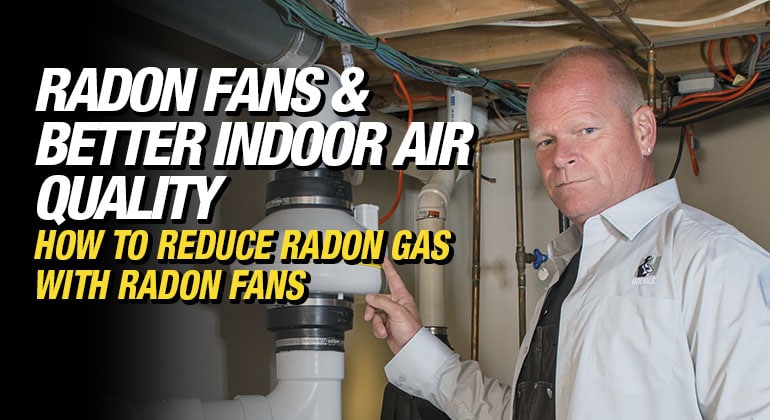
Radon Fans and Better Indoor Air Quality
By Mike Holmes
Mike’s Advice / Home Safety & Maintenance
Wednesday, April 13th, 2022 @ 9:15am
How to reduce radon gas with radon fans
Radon Gas and Radon Fans
I have been talking about the dangers of radon gas for years. You have seen me talk about this on my shows as well. It’s something I really want you all to be aware of. Radon gas is formed when the uranium in our soil and rocks breaks down. If this occurs outdoors, the radon gas will dissipate harmlessly. However, when this process takes place inside our homes, the radon can build up to dangerous levels and can potentially cause lung cancer. Radon-induced lung cancer is the leading cause of lung cancer – only after smoking. And if you’re a smoker, you become even more vulnerable. It’s important to take this stuff seriously because it can do some real damage. Radon fans are a part of the radon mitigation system that pulls air from the soil and vents it outdoors through a pipe that ends above the edge of the roof.
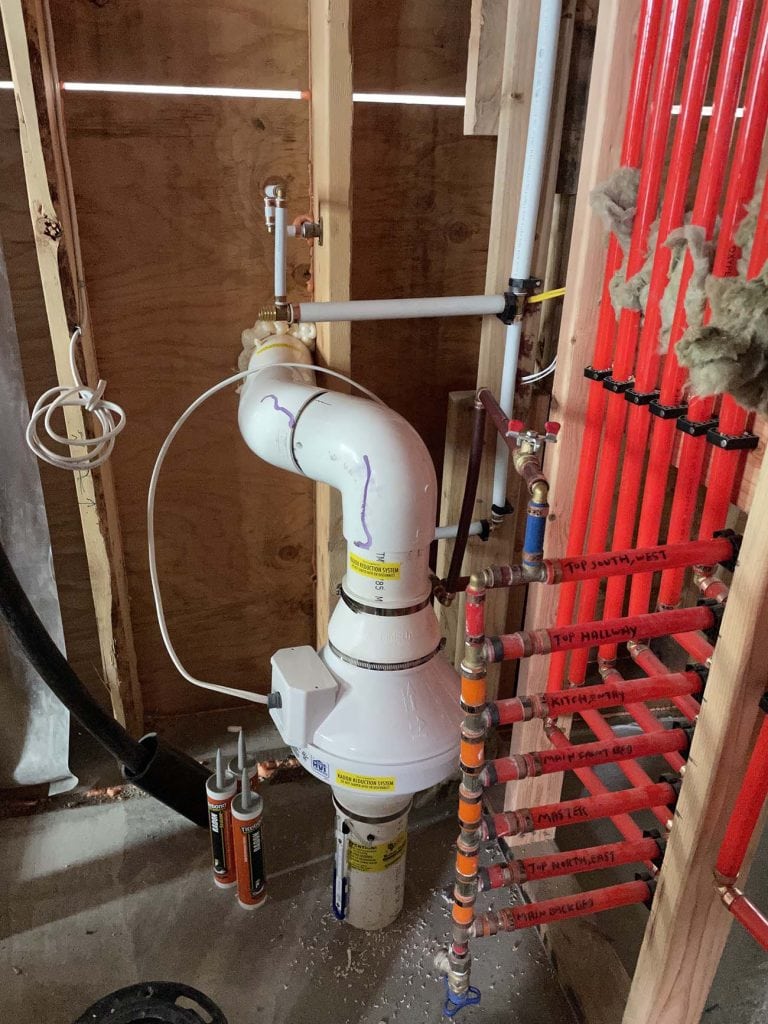
Active soil depressurization system using RN4EC4 Fan
Where does radon come from in a house?
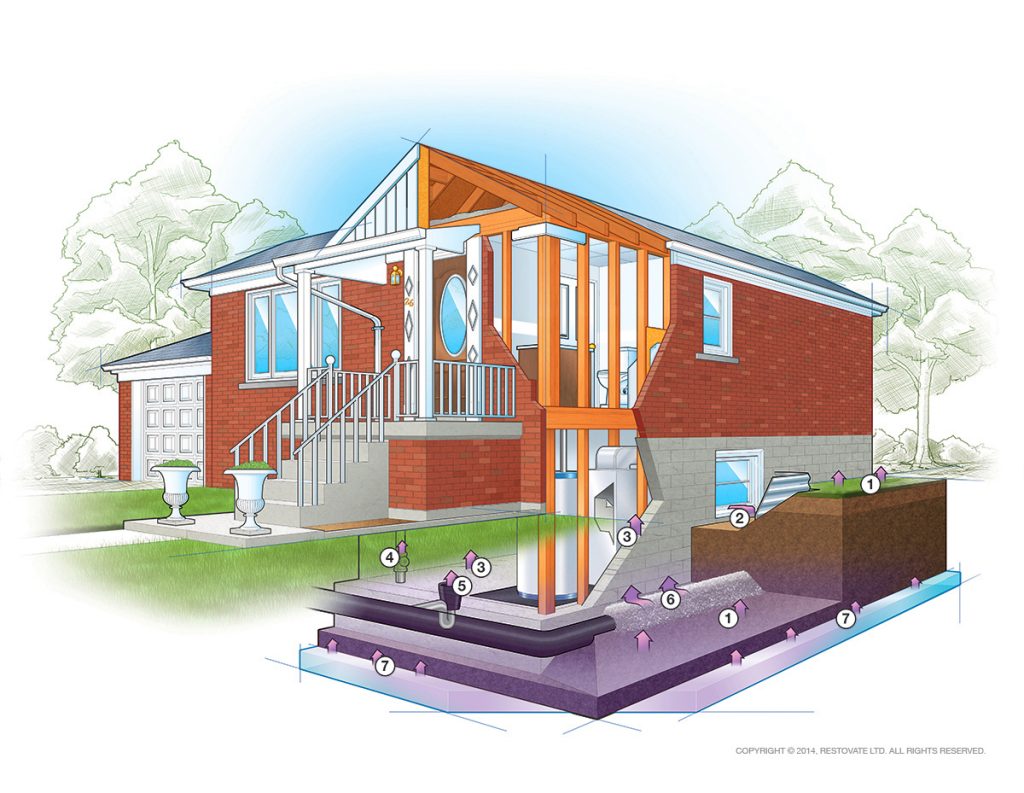
Radon can seep into a home through pipes, windows, sumps, unfinished floors, cracks in foundation walls, and floors-even through foundation walls.
There are a few ways radon may sneak into your home. Radon can enter the home from any place it comes into contact with the ground. This could be through:
- the sump pump,
- cracks in the foundation,
- window casements, and more.
Even if the home is well-sealed, radon can find a way in. It’s tricky like that. Because our homes tend to be better insulated and have fewer air exchanges, to reduce energy consumption, the gas will concentrate and does not escape.
If your home uses well water, this is another potential entry point. When you turn on your taps and showers, the soluble radon in the water gets aerated and off-gasses into the home for you to inhale, as well as ingest. If you use groundwater well at home, include that in your testing plan.
Radon and Indoor Air Quality
Radon is a radioactive gas that escapes from the ground and can enter your home. Under concentrated levels these radioactive particles are deposited into the air we breathe, damaging DNA and causing lung cancer. If you don’t test your home, radon gas is one of the major pollutants of poor indoor air quality.
RELATED
Does Radon Travel Upstairs?
Radon gas is more commonly found in a home’s basement and main level. However, because radon gas may easily flow throughout a home or building, increased radon levels can be discovered on the first and second floors.
When it comes to radon levels in certain parts of a home, there are numerous factors to consider. The type of construction, the home’s insulation and air sealing, the time or season, and the type of heating system all influence radon levels in a home. Levels can vary significantly from season to season, floor to floor, and even room to room. So, if you live in a high-radon area or know you have excessive radon levels in your home, it’s ideal to test for radon on the top levels of your home.
RELATED
If you are in Canada, you can check out the map here for radon levels by areas.
What are the Radon Symptoms in a Home?
You won’t know if you have radon unless you test for it. However, if you are feeling unwell and having trouble breathing, a persistent cough, tightness or pain in the chest, continuous hoarseness, or trouble swallowing – these could be signs of early lung cancer, which can be caused by high levels of radon exposure over an extended period of time.
Get Your Home Tested
How do you know if your home has dangerous levels of radon gas? The only way to know for sure is to get your home tested. There are several ways to get your home tested, using either a short term or long term test. If you do a short-term test, it is recommended to get a long-term test as radon levels fluctuate. Consult with a C-NRPP certified professional.
RELATED
How often should you test your home for radon?
Health Canada recommends that you test for radon in your home every two years OR if you’ve had significant renovations and have changed your air exchange systems, with the installation of a new HVAC system, ERV or HRV, and or air conditioner.
When is the best time to test for radon in your home?
The best time to test your home for radon is during the fall or winter months since your doors and windows are closed up. As a result, radon levels are typically higher during the winter months.
What are Radon Fans?
A radon fan is a device that is used to reduce and prevent the buildup of radon gas in your house. A radon fan prevents radon from rising through the foundation and into your home by using negative pressure. Radon gas is drawn from beneath your home and released outdoors via a pipe and radon fan. Radon fans are made to be airtight, silent, and energy efficient.
Because the radon fan housing must be entirely sealed, it is manufactured to a higher quality than other types of fans. To avoid radon contamination of the home’s interior air, there must be no air leakage between the fan and the residence, as there must be between all other elements of the radon mitigation system.
Only C-NRPP-approved and listed radon fans will be used by C-NRPP professionals.
Is a radon fan necessary?
A radon fan isn’t always necessary for a system to function correctly and reduce radon levels to a safe level. A passive radon system is pre-installed in many newly constructed homes to help vent gasses out of the house. Passive solutions are not as effective as adding a radon fan to the system. Radon levels should be kept below 4.0 pCi/L, according to the EPA.
Some radon mitigation systems are classified as “passive,” meaning they have a mitigation mechanism but no active radon fan.
These radon devices frequently fail and are ineffective at keeping radon levels below a safe level. A radon fan’s purpose is to create a negative pressure beneath the concrete sub slab in a basement. Below that, the fan creates negative pressure. Because radon follows the path of least resistance, creating this negative pressure will draw it to the pipe.
Types of Radon Fans

Radon Mitigation Fan
The radon mitigation fan is the most important element of a mitigation system.
There are 3 main categories of radon fans:
- Low suction, low airflow
- Moderate suction, moderate to high airflow
- High suction, low airflow
Low suction, low airflow radon fans
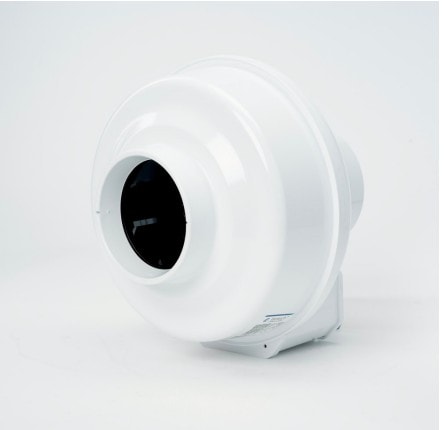
Rn1 Inline Radon Fan, low suction and low airflow
Low suction and low airflow fans are typically used when there is drain tile or 4 to 6 inches of gravel under your property. They are also often added to a passive radon reduction system that is installed when a new home is built. These are the quietest fans, as the draw level is quite low.
Moderate suction radon fans
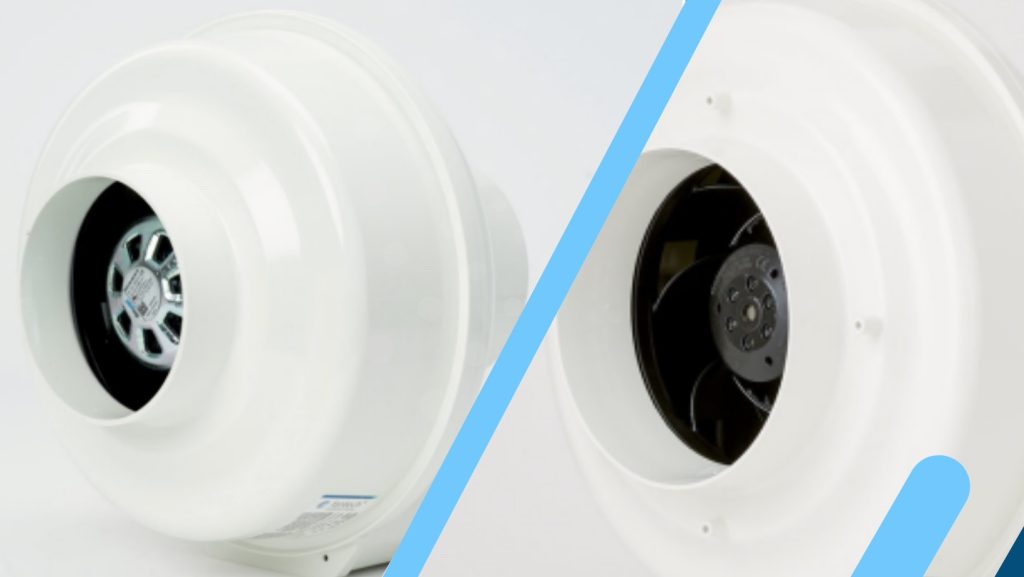
Rn 2EC and Rn 3 Inline medium and moderate suction and medium and low airflow radon fans
Moderate suction fans are designed for medium- to large-sized homes with gravel or drain tile beneath the concrete slab. They can move a lot of air without a strong suction. This indicates that the material beneath your property is porous, or that the slab contains numerous fractures and holes. The leakiest houses are those with drain tile and concrete block walls.
When feasible, cover openings to the earth to prevent the radon system from sucking conditioned air (air you pay to heat and cool) out of your home. A radon system that takes too much air from within your home might produce a backdraft in equipment such as your water heater. As a result, the consequences of carbon monoxide pose a major threat to your family.
Also, high flow fans tend to be noisy and may require a noise suppressor.
High-suction Radon Fans
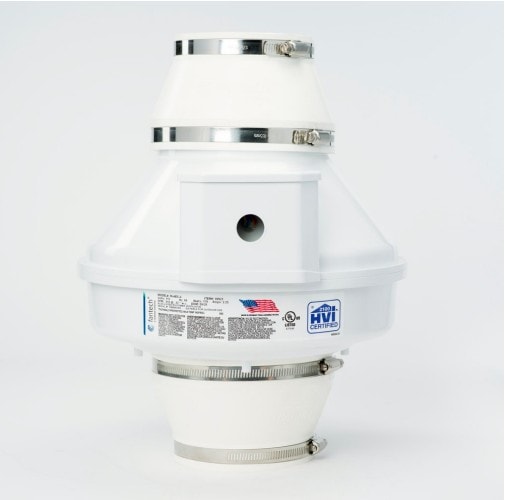
Rn 4EC-4 Inline Radon Fan with high suction and high airflow
Tight soils, such as clay and sand, usually require a high-suction fan. If the earth beneath your property is compacted, you may need more than one suction point to generate a vacuum beneath the whole structure. Again, due to the high suction rate, these fans tend to be noisy and will require a noise suppressor.
There are fans that can combat radon without having to penetrate a home’s slab. The following is a list of the various types of fans used in radon mitigation systems, which will aid in the selection of the best radon mitigation system for one’s home.
An excellent example of a high-suction radon fan is the RN4EC-4 INLINE RADON FAN.
Room Pressurization Fans
These fans are mounted above ground and pull air from the outdoors or the upper levels of a house into the basement. The concept is that these fans can change the air pressure in the basement, causing radon to be pushed down rather than drawn up. They operate entirely above ground and are the simplest to install, but they are the least effective.
The performance is influenced by the climate, house construction, and the amount of time that doors and windows are open in the house. These fans should only be considered in smaller residential homes after more efficient SSD fans have been considered.
High Flow SSD Radon Fans
These fans are commonly found in homes undergoing radon mitigation upgrades. They prevent air leakage and are especially useful beneath foundations where there isn’t enough gravel to make the sub-slab layer very porous.
The largest and most powerful fans, with the highest flow rates, are used for massive structures such as schools and office buildings. High flow fans for homes typically use 4 to 6-inch piping and may require more than one slab penetration to function properly.
However, large industrial fans of this style will require 6 to 10-inch piping as well as numerous slab penetrations and exhaust ports to function properly.
Suction SSD Fans
Suction fans are most effective in areas where the sub-slab material is not porous. This is most common where there is sand or dense clay beneath the slab. In order to draw enough air, these fans typically require 3-inch piping and multiple slab penetrations. The larger versions of these fans are recommended for areas where the air is thinner, such as at higher altitudes.
Where should radon fans be located?
The radon vent system is common to all radon sub depressurization methods, and the radon fan should run continuously. When connected to a sub-system and PVC or AVS piping, radon gas will be drawn from the soil and is exhausted to the exterior of the home.
The system can be routed in the interior of the home or the exterior of the home, as long as the discharge is above the eaves of the house and at least 10 ft away from building openings, and less than 2 ft below the discharge so the discharge gasses cannot re-enter the home.
The discharge piping should not be routed through conditioned spaces and therefore good fan location is in the attic, garage, and outdoors and should NOT be in a space inside the home, like a crawlspace, or in a garage with living space above them.
How long does a radon fan last?
Fans may last five years or longer (manufacturer warranties rarely exceed five years) before needing a repair or replacement. A fan replacement will cost between $300 and $600, including parts and labor. Retesting your home every 2 to 3 years is recommended to ensure that radon levels remain low.
What is back drafting in a home?
It is advised that any active depressurization system be checked to ensure that it does not create back drafting of combustion appliances in the home, such as a furnace, water heater, fireplace, or wood stove. When a room containing a combustion device is depressurized to the point where smoke and combustion gasses flow inside the residence instead of venting outdoors, this is known as backdrafting.
A professional radon-reduction specialist or a heating contractor can do backdraft testing.
What is a fan curve chart?
A fan curve chart allows a radon pro to choose the best fan for your needs. It takes into consideration the air volume flow rate (or CFM), the static pressure (wg – inches or mm water gauge), and break horsepower (bhp or kW). By knowing the fan speeds, the blade pitch angles, and the fan’s noise level at different CFM, a pro can determine the best fan for the job.
How do you know if your radon fan is working properly?
A U-tube manometer is a monitoring device that will let you know when the fan is not working correctly. There is also an active notification monitor, which sounds an alarm if the radon fan is not working correctly.
What is a Suction Pit?
A pit is dug below the basement floor where the radon pipe pulls radon.
Did you know every radon mitigation system is tagged with the installer name, phone number, installation date, and license number?
Also, most manufacturers of radon fans have warranties for 5 years from the date of installation against mechanical failure. **Note – 5-year fan warranties are for professionally installed systems.**
How to select the right radon mitigation fan?
The best way to select the right mitigation fan is to conduct tests and collect data. Creating suction under your entire home is often the key to getting radon levels under control. By doing tests a pro can determine the number of suction points, the size of the vent pipe, and which fan is best for your home by measuring both pressure and airflow.
Why test for radon?
You might not think about it, but it’s been said on average that we spend about 90% of our time indoors. And of course, this year, most of that time spent indoors is centralized in our own homes. That’s a significant time spent potentially breathing in pollutants like mold, mildew, and, yes, radon.
Radon is colorless and odorless, so you can’t see, smell, or taste it. If you don’t test, you can’t know the levels in your home. Radon gas concentrations can vary wildly in your neighborhood. Even if your neighbor has low levels, your house may not be so lucky.
To me, it makes sense to take the time to test your home for radon. You can order a test kit online, and send it off to a lab for results. They’ll tell you if your radon levels are at a concerning level and if you should take steps to mitigate it.

The only way to know if you have radon is to test for it.
In Canada, radon is measured in becquerels per cubic metre (Bq/m3). If your radon levels test above 200 Bq/m3 you’ll want to take steps to mitigate radon in your home. But even if you test below that, it’s not a bad idea to mitigate radon in your home. Better safe than sorry.
Mitigating Radon
Your best bet to avoid radon problems is to keep it out of the home in the first place.
For new construction homes, there are sub slab ventilation and membrane products you can install underneath your slab which are designed to keep the gas from migrating through the slab and into your home. I am a big fan of Radon Guard and Radon Block.
For your current home, the best option is to use your preexisting heat recovery ventilator (HRV). There are devices on the market that you can attach to your HRV, which can detect if your home experiences a spike of radon gas. It will cause the HRV to kick in, triggering an air change in your home, bringing in fresh, treated air, and cycling the radon-infused air harmlessly outdoors. We have installed the Radostat on our HRVs for this purpose. Highly recommend it!
You can install a mitigation system in your well water that will aerate the water, stripping the harmful radon out of the water before it enters your home.
How Much Does Radon Mitigation Cost?
Typically, it doesn’t cost much to mitigate the effects of radon in a home. Generally, you’ll be paying between $1,500 to $3,000. It doesn’t cost much money – and it’s a smart way to spend your renovation dollars if your home tests positive for high levels of radon.
Here are your radon mitigation options:
- Airwell for well water
- Radostat for your HRV
- Radon Guard and Radon Block for new homes
RELATED
Does opening a window reduce radon in your home?
Yes, opening windows improves air circulation and ventilation. However, if you have radon in your home you need to properly address the situation with a mitigation system that is right for your home. Contact a professional to find a solution.
Can an air purifier filter remove radon gas from the air?
No. Air purifiers are great for mold, dust, allergies, and bacteria. There are some claims that radon particles can be trapped. However, this is not an effective radon reduction solution. You need to contact and work with a radon mitigation specialist.
READ NEXT
Healthy Homes and Building Biology
How To Improve Your Indoor Air Quality








